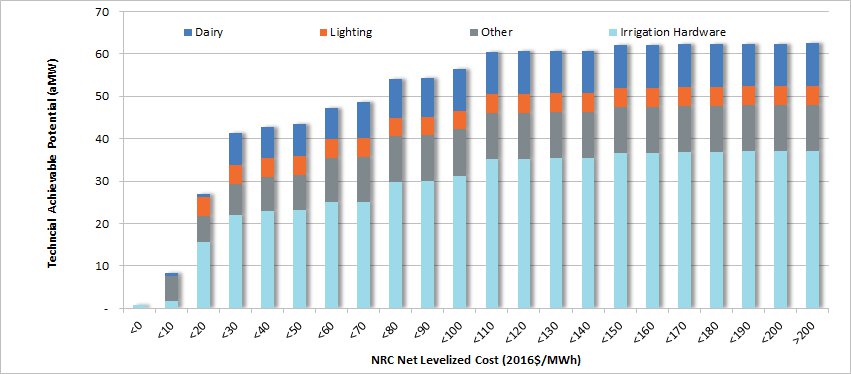In the 2021 Plan, the agricultural sector comprises irrigation efficiency, energy efficiency at dairy farms, as well as lighting and other improvements. According to the U.S. Department of Agriculture (USDA) Irrigation and Water Management Survey (2018), there are approximately 6 million acres of irrigated land in the Northwest; more than half of which is irrigated using pivot or linear sprinkler systems. The 2017 USDA Census of Agriculture indicates there are about 2,500 dairy farms in the region, comprising nearly 1,000,000 head of cattle. The 2021 Power Plan identified 73 average megawatts of potential, 56 of which is at a net levelized cost of less than $100 per megawatt-hour. The total potential represents about seven percent of the agricultural sector load. In addition to the energy savings, the agricultural measures provide approximately 24 megawatts of winter peak savings and 171 megawatts of summer peak savings [1]. The summer peak impacts are much greater given that most irrigation occurs during the summer months.
The largest source of efficiency potential is found in irrigation system improvements, accounting for nearly 55 average megawatts, or about 75 percent of the total. Within irrigation, nearly one-half of the potential is from irrigation hardware and upgrades. The remainder is from system pressure reduction (approximately one-quarter), motor and pump improvements (about 15 percent), and variable rate irrigation (about 15 percent). Dairy and other livestock farm efficiency measures comprise in total about 13 average megawatts, or 18 percent of the potential. Over 40 percent of this is from dairy refrigeration measures. Ventilation measures, lighting, and energy-free stock tanks round out the remainder, each contributing two to three average megawatts. Finally, there is savings potential from exterior area lighting (4.5 average megawatts) and a small potential from circulating engine block heaters (0.2 average megawatts).
The agricultural supply curve by end use is provided in figure below.
Agricultural Efficiency Supply Curve

[1] As based on impact during 6pm of a winter or summer weekday



